|
|
|
Sort Order |
|
|
|
Items / Page
|
|
|
|
|
|
|
| Srl | Item |
| 1 |
ID:
138248
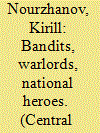

|
|
|
|
|
| Summary/Abstract |
The history of the Basmachi movement has occupied a prominent place in the construction of a collective past in Soviet and post-Soviet Tajikistan. This article traces the evolution of its representations in the dominant narrative from the 1950s to the present day. It argues that official discourse in contemporary Tajikistan situates the Basmachis in the mould of a national struggle against Turkic oppression, rather than portraying them, in the manner of earlier prevalent models, as part of a class-based or anti-colonialist resistance. Among many public counter-narratives, the one focusing on the local appeal of the Basmachi leaders has the greatest potential to challenge the government-sponsored reading of Tajikistan’s past and thus the image of a unified nation it seeks to support.
|
|
|
|
|
|
|
|
|
|
|
|
|
|
|
|
| 2 |
ID:
138246


|
|
|
|
|
| Summary/Abstract |
The Battle of Gökdepe (1881) is considered to be a turning point in Turkmenistan’s contemporary historiography. It led to the then independent Turkmen (Akhal Tekke in this case) tribes coming under Russian control. Almost immediately after the event the battle became a controversial point of interpretation starting from Turkmen sources (rarely known to us), an immense number of Russian (mostly military) sources, up to the Soviet historians. The post-Soviet official Turkmen historiography of the event came from these foundations, but used its own mythological approach. As a result, the contemporary narrative of the Gökdepe defeat turned into a victory for the Akhal Tekke (and broadly Turkmen) nation. Additionally, this paper argues that the first and partly the second presidents of Turkmenistan incorporated the battle into their own personality cults, a fact which is still specific to the Central Asian context, albeit not unique in world history. In particular, the first president usurped the myth and connected it with his own historical narrative. The second president continues this in the frames of the already settled political culture in the country, adapting the Gökdepe myth to create his own ideological story. Therefore, the appropriation of the historical event in Turkmenistan represents a specific (albeit not unique) case of this kind and shows the way of thinking about the leader in current Turkmenistan.
|
|
|
|
|
|
|
|
|
|
|
|
|
|
|
|
| 3 |
ID:
138249
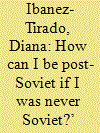

|
|
|
|
|
| Summary/Abstract |
Based on anthropological fieldwork conducted in the Kulob region of southern Tajikistan, this paper examines the extent to which the existing periodization ‘Soviet/post-Soviet’ is still valid to frame scholarly works concerning Central Asia. It does so through an analysis of ‘alternative temporalities’ conveyed by Kulob residents to the author. These alternative temporalities are fashioned in especially clear ways in a relationship to the physical transformations occurring to two types of housing, namely flats in building blocks and detached houses. Without arguing that the categories ‘Soviet’ and ‘post-Soviet’ have become futile, the author advocates that the uncritically use of Soviet/post-Soviet has the unwanted effect of shaping the Central Asian region as a temporalized and specialized ‘other’.
|
|
|
|
|
|
|
|
|
|
|
|
|
|
|
|
| 4 |
ID:
138253
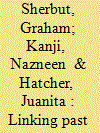

|
|
|
|
|
| Summary/Abstract |
The 1895 Pamir Convention divided the mountainous region of Badakhshan into separate entities under Russian and British/Afghan influence, leading to a remarkable divergence in the development fortunes of a people once united by kinship. For those in today’s GornoBadakhshan in Tajikistan, incorporation into the Soviet Union brought investments in education, health, physical infrastructure, and the economy. People living in Afghanistan’s Badakhshan Province retained more political freedom but lived remotely within a feudal state where development investment was limited. In recent decades, both regions have experienced conflict that has affected their development. In this article, we use findings from quality of life assessments carried out by the Aga Khan Development Network to illustrate the stark differences between the Badakhshans. We discuss ongoing efforts to implement cross-border development programmes to improve quality of life in both Badakhshans, while noting that their success depends on a stable security environment in the region.
|
|
|
|
|
|
|
|
|
|
|
|
|
|
|
|
| 5 |
ID:
138247
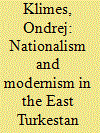

|
|
|
|
|
| Summary/Abstract |
This study explains the intellectual history and ideology of the Turkic insurgency and the East Turkestan Republic in Kashgar in 1933–34. Texts in periodicals from the period suggest that the insurgency was defined by its intellectual elites more as a nationalist enterprise than as a religious one. The insurgency’s ideologists established important national attributes of the East Turkestani nation, particularly its national name, homeland, symbology, and history, and they also articulated East Turkestani national interests, particularly political independence, representative government, and modernization. Regardless of the arguably low degree of social penetration of the ideas of the elites among common society and the small extent to which policy was actually implemented, the intertwining of East Turkestani national identity and interests with political self-government and modernization was an ideological concept that had a profound impact on all subsequent administrations in Xinjiang.
|
|
|
|
|
|
|
|
|
|
|
|
|
|
|
|
| 6 |
ID:
138252
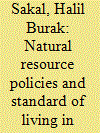

|
|
|
|
|
| Summary/Abstract |
This paper evaluates Kazakhstan’s natural resource policies and their impact on the standard of living of the Kazakhstan population within the framework of three determinative factors: globalization and international markets; Soviet legacy and ‘resource nationalism’; and Nursultan Nazarbayev and his authoritarian leadership. It argues that natural resource policies of Kazakhstan failed to improve the living standards of the majority of people in Kazakhstan, especially the poor and those living in oil-producing and rural areas, despite increasing oil prices and revenues. The argument will be supported with an analysis of Kazakhstan’s oil wealth distribution in light of global initiatives as well as with evidence derived from official reports and statistical data to find out whether Nazarbayev’s widely discussed ‘resource nationalism’ is ‘nationalistic’ enough to favour the whole nation.
|
|
|
|
|
|
|
|
|
|
|
|
|
|
|
|
| 7 |
ID:
138251
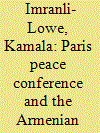

|
|
|
|
|
| Summary/Abstract |
The South Caucasus, which includes Armenia, Azerbaijan and Georgia, is one of the most challenging regions in the world, owing to its long-lasting and ongoing conflicts. One of these conflicts is between Armenia and Azerbaijan, the current stage of which has continued for 25 years without any prospect of a settlement in the near future. For a better understanding of this conflict it is necessary to go back to 1918 and 1919, which witnessed the emergence of the first Azerbaijan and Armenian Republics. The article examines and assesses the ethnic, historical, economic, geographical and security arguments submitted by the Armenian government to the Paris Peace Conference in 1919 to substantiate its vision of territorial delimitation between Armenia and Azerbaijan regarding Garabagh. The article argues that Armenian nationalism was ethnic nationalism and that the Armenian government constructed politically motivated arguments to substantiate its claims to Garabagh, which were part of its nationalist aim of constructing an Armenian ‘ethno-nation’ in the area from the Mediterranean to Garabagh.
|
|
|
|
|
|
|
|
|
|
|
|
|
|
|
|
| 8 |
ID:
138250
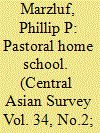

|
|
|
|
|
| Summary/Abstract |
Literacy before and after the 1921 People’s Revolution in Mongolia has been largely represented by socialist historiography and post-socialist urban perspectives, which have rendered unofficial and non-pragmatic literacies invisible. This study explores rural, vernacular and grassroots literacy theories to recontextualize the pre-revolutionary category of Mongolian home schooling and to offer a new perspective – pastoral literacy – which enables historians and other researchers of Central Asia to represent the literacy practices of non-urban semi-nomads more accurately and vividly. This study applies the pastoral literacy perspective to literacy narratives extracted from University of Cambridge Oral History of Twentieth Century Mongolia interviews and demonstrates that pastoral home schooling was a socially and culturally salient domain for acculturating young Mongolians into the 1960s. Mongolian pastoral home schooling consisted largely of personal, male teacher–student relationships, authoritative teaching models, alphabet-based curricula, as well as texts and materials adapted from dominant religious and state literacies.
|
|
|
|
|
|
|
|
|
|
|
|
|
|
|
|
|
|
|
|
|